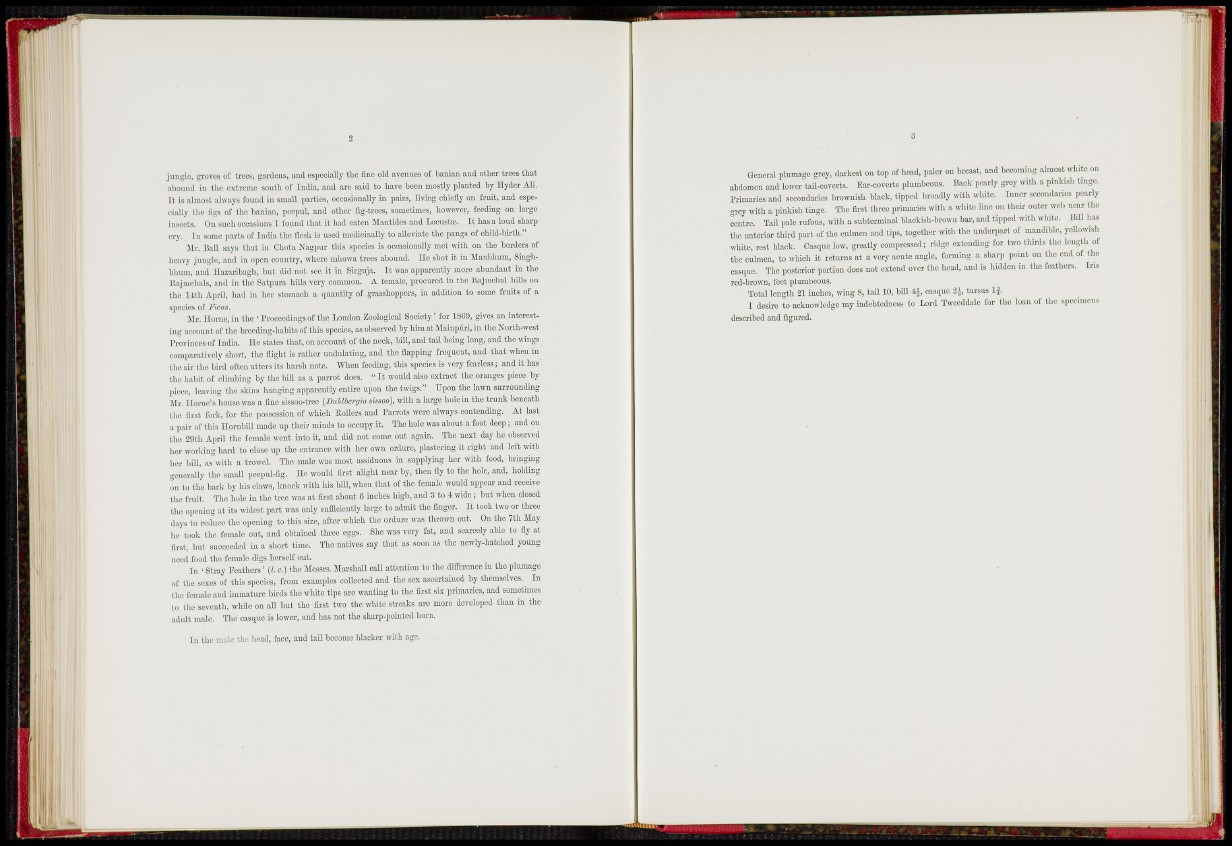
jungle, groves of trees, gardens, and especially tlic fine old avenues of banian and ether trees that
abound in the extreme south of India, and are said to have been mostly planted by Ilyder AH.
It is almost always found in small parties, occasionally in pairs, living chiefly on frnit, and especially
the iigs of the banian, pcopul, and other fig-trees, sometimes, however, feeding on large
insccts. On such occasions I found that it had eaten ilantides and Locusta;. It has a loud sharp
cry. In some parts of India the flesh is used medicinally to alleviate the pangs of child-birth."
Mr. Ball says that in Chota Nagpur this species is occasionally met with on the borders of
heavy iungle, and in open country, where mhowa trees abound. He shot it in Manbhum, Singhbhum,
and nazaribagh, but did not see it in Sirguja. It was apparently more abundant in the
llajmehals, and in the Satpura hills very common. A female, procured in the Eajmehal hills on
the 14th April, had in her stomach a quantity of grasshoppers, in addition to some fruits of a
species of Ficus.
Mr. Home, in the • Proceedings of the London Zoological Socicty ' for 1869, gives an mteresting
account of the breeding-habits of this speeics, as observed by him at Mainpuii, in the North-west
Provinces of India. He states that, on account ot the neck, bill, and tail bomg long, and the wings
comparatively short, the flight is rather nndulating, and the flapping frequent, and that when in
the air the bird often utters its harsh note. When feeding, this spocies is very fearless; and it has'
the habit of climbing by the bill as a parrot does. " It would also extract the oranges piccc by
piece, leaving the skins hanging apparently entire upon the twigs." Upon the lawn sm-roundmg
Mr. Home's house was a lino sissoo-trec (HaUhergm susoo], with a large hole in the trunk beneath
the first fork, for the possession of which Rollers and Parrots were always contending. At last
a pair of this Ilornbill made np their minds to occupy it. The hole was about a foot deep; and on
the 29th April the female went into it, and did not como out agam. The next day he observed
her working hard to olosc up the entrance with her own ordure, plastering it right and left with
her bill, as with a trowel. The male was most assiduous in supplymg her with food, bringing
generally the small peepul-fig. He would first alight near by, then fly to the hole, and, holding
on to the bark by his claws, knock with his bill, when that of the female would appear and receive
the fruit. The hole in the tree was at first about 6 inches high, and 3 to 4 wide ; hut when closed
the opening at its widest par-t was only snfileiently large to admit the finger. It took two or three
days to reduce the opening to this siae, after which the ordure was thrown out. On the 7th May
he took the female out, and obtained thr-ee eggs. She was very fat, and scarcely able to ily at
first, but succeeded in a short time. The natives say that as soon as the newly-hatched young
need food the female digs herself out.
In ' Stray leathers' {I. c.) the Messrs. Mai-sball call attention to the difl'erence in the plumage
of the sexes of tills species, from examples collected and the sex ascertamed by themselves. In
the female and immature birds the white tips are wanting to the first six primaries, and sometimes
to the seventh, whUe on all bat the first two the white streaks are more developed than in the
adult male. The casque is lower, and has not the sharp-pointed horn.
In the male tlic head, faee, and taU become blacker with age.
a
General plumage grey, darkest on top of head, paler on breast, and becoming almost white on
abdomen and lower tail-eoverts. Ear-eoverts plumbeous. Baok pearly grey with a pinliish tinge.
Primaries and seeondai-ics brownish black, tipped broadly with white. Inner secondaries pearly
-rey with a pinkish tinge. The fii'st three primaries with a white line on their outer web near the
Mutre Tail pale rufous, with a subterminol blackisb-brown bai', and tipped with white. Bill has
the anterior third part of the cuhnen and tips, together with the underpart of mandible, yellowish
white test black. Casque low, greatly compressod; ridge extending for two thirfs the length ot
the culmen, to which it returns at a very acute angle, forming a sharp point on the end of the
casque. The posterior portion does not extend over the bead, and is hidden in the feathers. Ins
red-brown, feet plumbeous.
Total length 21 inches, wing 8, tail 10, bfll casque 2J, tarsus If.
I desire to acknowledge my mdehtcdness to Lord Twccddalc for the loan of the specimens
described and figured.
msBom